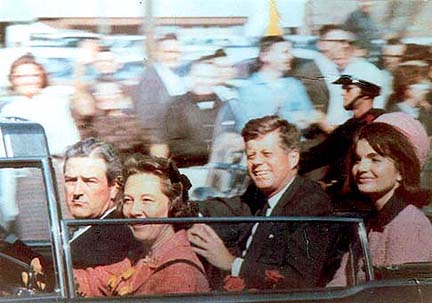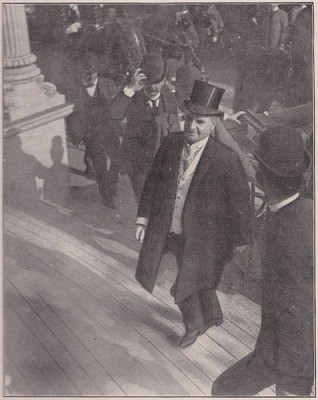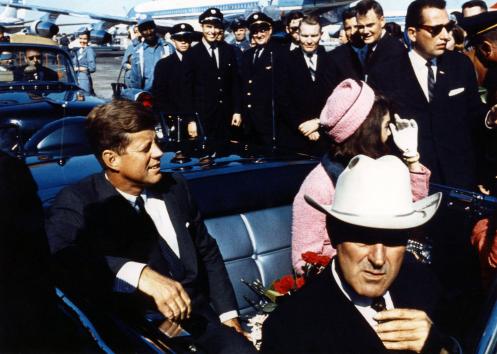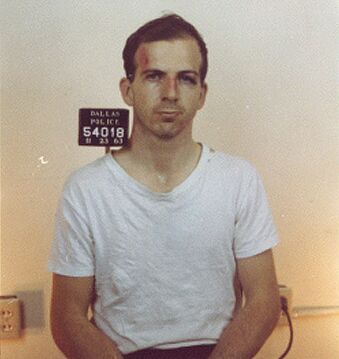FIFTY YEARS AGO THIS WEEK, any number of once and future U.S. presidents, John Birchers, CIA operatives, Mafia hit men, pro-Castro dissidents, seedy nightclub owners, crooked cops, bumbling Secret Service agents, and home movie enthusiasts converged in that crucible of seething reactionary extremism that was Dallas, Texas, and together boarded the motorcade to history.
Five decades of media saturation have familiarized all of us with the keywords: Zapruder film, Lee Harvey Oswald, Jack Ruby, lone gunman, magic bullet, Dealey Plaza, Book Depository, grassy knoll. In that time, a plethora of theories, presented as fiction (American Tabloid by James Ellroy, Libra by Don DeLillo, Stephen King’s 11/22/63) and non-(Thomas Buchanan’s Who Killed Kennedy?, Crossfire by Jim Marrs, Vincent Bugliosi’s Four Days in November) have been advanced on how JFK was killed, and why, and by whom. Was he was gunned down by a demented loner with Communist sympathies? A Corsican assassin in the grassy knoll sent by mob boss Sam Giancana? His own Secret Service detail by mistake?
Half a century later, questions still remain unanswered. And therein lies the fascination. November 22, 1963, was not just the day JFK died. It was also the day American conspiracy theory was born.
~
There were conspiracies in this country before JFK—indeed, it could be argued that these United States of America were a product of the nation’s very first conspiracy—and his assassination was neither the first nor the most momentous among fallen U.S. presidents; Lincoln’s claims both of those distinctions. Yet 11/22/63 was the first to combine the four ingredients necessary for a tragic historical event to inspire enduring conspiracy theories. To wit:
 Ingredient #1: The Tragic Event
Ingredient #1: The Tragic Event
Conspiracy theories, at least the ones that endure, begin with a bang. Something really bad has to take place. It has to be unexpected, it has to be man-made—no one claimed Hurricane Katrina, the weather event, was a conspiracy, except perhaps for the wingnut preachers who blamed it on the gays—and it has to be so egregiously atrocious that it unites the country in stunned horror.
A battleship is sunk. A naval harbor falls victim to surprise attack. Skyscrapers come tumbling down. A president is shot.
Not all tragic events generate enduring conspiracy theories, of course. Sometimes, bad things just happen. On July 2, 1881, not yet four months into his term in the White House, President James Garfield was shot by Charles Guiteau, who was by any professional or colloquial standard off his rocker. Just fourteen years after the assassination of Abraham Lincoln, this was a horrible event, made more horrible by the way poor Garfield died of his wounds, slowly and painfully, 11 weeks later. But there is no Garfield conspiracy. His shooting was just a tragic event, nothing more and nothing less.
The Kennedy assassination was a tragic event—the tragic event, it could be argued, of the American century. It also had three other elements that the Garfield assassination lacked.
Ingredient #2: Unsatisfactory Official Explanation
President William McKinley was a likeable, sociable fellow who liked to get out with people—the sort of man citizens might yen to have a beer with. He was a tool of Big Business and a proponent of American Empire. During his term, the United States fought a war with Spain, the popular appetite for which was ginned up by a rabidly pro-war media that hopped on a perceived threat to national security, and subsequently took possession of the Philippines, Guam, and Puerto Rico. Although he made some concessions to labor, he was despised by the American left. Emma Goldman called him “president of the money kings and trust magnates of this country.” In short, he was George W. Bush 1.0.
On September 5, 1901, McKinley made a public appearance at the Pan-American Expo in Buffalo, N.Y. As he hobnobbed with well-wishers at the Temple of Music, he was shot twice in the abdomen by Leon Czolgosz, an anarchist sufficiently moved by the speeches of Goldman to take arms against his oppressors. McKinley would become the third U.S. president to be assassinated.[1. Robert Lincoln, son of Abe, was an eyewitness to the Garfield assassination AND was at the Expo when McKinley was shot. He would subsequently decline all offers to visit the White House, saying, “No, I’m not going, and they’d better not ask me, because there is a certain fatality about presidential functions when I am present.”]
While his death is certainly a tragic event, there is not a body of McKinley Assassination conspiracy theory literature (although one book does exist), despite the fact that Czolgosz was a walked-in-from-Central-Casting villain, the Mohammad Atta of his age (which I suppose makes Goldman 1901’s Osama bin Laden). The reason for this is simple: no one disputes the official version. Hundreds of witnesses saw Czolgosz shoot the president—including the president himself, who did not die of his wounds until nine days later. Whether or not “the Italian” was an accomplice in the assassination, as some allege, is more or less irrelevant. Czolgosz was indisputably an anarchist, the anarchists were not displeased with the result of his actions, and McKinley’s demise gave the keys of the car to Teddy Roosevelt, who kicked off a grand era of progressive government. When the working classes win, there’s no conspiracy.
If the JFK conspiracy theorists agree on anything, it’s that The President’s Commission on the Assassination of President Kennedy, better known as the Warren Commission Report, is full of holes. The Church Committee, in its expansive review of the U.S. intelligence apparatus in 1974, “developed evidence which impeaches the process by which the intelligence agencies arrived at their own conclusions about the assassination, and by which they provided information to the Warren Commission. This evidence indicates that the investigation of the assassination was deficient.” No less an authority than Bobby Kennedy, then the Attorney General and always JFK’s kid brother, believed the official report was “a shoddy piece of craftsmanship.”
We have senators and attorneys general, to say nothing of the leagues of independent investigative journalists, telling us that the official version of the assassination is not to be trusted. How then can we trust it?
Ingredient #3: Lack of Transparency
For a Secret Service that failed spectacularly in its essential mission, and for a John Birch police department that could neither protect nor serve that fateful day, the alleged perpetrator of the crime sure was found right quick. Oswald acted alone, we were told. And then, before the lone assassin could be properly questioned, he was shot dead by the owner of a seedy nightclub, on national TV! Why did Jack Ruby do that? Was it really patriotism? Why did the Dallas PD allow him near Oswald to begin with? While languishing in prison, Ruby hinted that there was more there than met the eye.
Fifty years later, there are still classified documents related to the JFK assassination. “Reputable groups and individuals have estimated that there are 1,171 unreleased CIA documents concerning Nov. 22, 1963,” Larry J. Sabato wrote last week in the Washington Post. “The Center for Effective Government has even claimed that there may be more than 1 million unseen CIA records related to Kennedy’s assassination.” Gerald Ford, who served on the commission and would go on to pardon Richard Nixon[2. Fun fact: Nixon was in Dallas the day JFK was killed.], would later write that during the commission’s probe, the CIA had covered up, benignly, key information about the assassination.[3. Ford did not waver from his belief that Oswald acted alone, however.]
Now, it may be that Oswald acted alone, that Ruby genuinely believed he was acting in his country’s best interests by whacking the little shit, that the CIA concealed evidence because revealing it would have jeopardized national security, and for no other reason. Sabato himself did a study using advanced audio techniques that supposedly debunks the two-shooter theory.
But when faced with high-level obfuscation, all those classified documents, and any number of inexplicable oddities related to the assassination, who doesn’t wonder: Why? What are they not telling us?
Ingredient #4: Sinister Motive
History altered its course ever so slightly when JFK died, to the benefit of some. There were obvious winners on 11/22/63. Without winners, there can be no lasting conspiracy.
JFK was going to pull the troops out of Vietnam. The military-industrial complex, which outgoing President Eisenhower famously warned about in his farewell address, could not tolerate what would have been a devastating blow to its finances, so they replaced the president with LBJ, who stayed the course in Southeast Asia.
One of the few presidents to ever have an expert’s grasp of economics, JFK perceived the truth about the Federal Reserve Bank—namely, that it is a privately-held enterprise that exacts a hefty fee for the right to print money, which responsibility the Constitution grants the Treasury exclusively. His intention was to wrest control of that function from the Fed and deliver it back to the American people, so the 13 Families who actually own the Fed had him removed.
Fidel Castro, who had survived the botched Bay of Pigs invasion, concluded that the Americans were out to get him, and struck preemptively. The Mafia, ordinarily no friend of Castro, decided to help out, because JFK had banged the moll of Giancana, a prominent mob boss, and because his Attorney General brother was going hard after organized crime.
I’m not saying any of these theories are true. But the first three ingredients make the arguments easier to advance. If the official version is fishy, and key players benefit so egregiously, it’s human nature to speculate on what really happened. Because the thing is, if even one part of the official version is false, then the whole thing cannot be trusted.
http://www.youtube.com/watch?v=iU83R7rpXQY
Most conspiracy theories wither and die because they lack one or more of these elements. If no one benefits from the tragic event, if it has no larger impact on history beyond its inherent horror, why do it?
The conspiracy theory community went apeshit after the Boston Marathon bombing, to no avail. Nothing about that heinous crime suggested a false flag. It took the FBI a few days to ID the killers, and they only found them after shutting down the city—not at all like Dallas, when Oswald was produced lickety-split. And other than perhaps an erosion of our civil liberties by our eager acceptance of a police state in one of our largest cities, what came out of it? Who gained? Rolling Stone?
What was the larger result of the Sandy Hook horror, another supposed conspiracy? President Obama did not take away our guns. On the contrary, he tried to get the NRA to close some loopholes on gun show purchases, and failed to do so. Almost a year has gone by since that atrocity, and still we allow Wayne LaPierre to treat the Republic like a battered wife.
None of the Obama conspiracies have stuck—Birther, Socialist takeover, imposing sharia law in the U.S., etc—because far from moving the nation in a radical leftist direction (or a radical Islamic one), he has ruled largely from the center, veering right only to drone-strike “terrorists” into oblivion. The guy is not a liberal. He’s an 80s-style Republican.
The moon landing was faked, because…why exactly? To scare the Soviets? Who gives a shit?
~
Any “truth” movement that has legs has legs because government censorship prevents the definitive refutation of a perceived sinister motive. It’s that simple. Thus, there’s only one way to make a conspiracy go away: reveal all.
In August, the CIA finally admitted complicity in the 1953 coup in Iran, when the democratically-elected leader Mohammad Mossadeq was assassinated. Agency involvement was rumored for decades; now we know the rumors were true. And now any lingering conspiracy theories are put to rest. [4. Those theories, it should be noted, were right.]
In 1992, President George Bush I—who was supposedly in Dallas on 11/22/63, working for the same CIA that supposedly whacked JFK—signed into law the Assassination Records Collection Act, requiring that all documents related to the assassination be declassified on October 26, 2017. At that time, President Hillary Clinton or Chris Christie can keep documents under wraps only if “identifiable harm to military, defense, intelligence operations, or conduct of foreign relations, and the identifiable harm is of such gravity that it outweighs the public interest in disclosure.” On that day in October, 54 years after the fact, the conspiracy theories will finally be put to rest. We’ll know for sure if Oswald acted alone. In the meantime, the JFK conspiracy, like the Dallas motorcade, speeds on.






Last week I watched, on PBS, “NOVA: Cold Case JFK”, and I thought it was a well-done, conclusive debunking of the “two shooter” hypothesis.
That doesn’t put to rest my main suspicion about JFK’s assassination – that “Oswald shoots JFK- the act of a deranged loner” followed by “Ruby shoots Oswald – the act of a deranged loner” lacks a certain dramatic coherence.
Be that as it may, some of the worst crimes in history are not hidden, but rather hideously apparent. Whether or not members of “the agency” arranged the murder of JFK, they and their ilk certainly were complicit in the murder of hundreds of thousands of Vietnamese and assorted neighbors, and dozens of thousands of Americans sent there in pursuit of anticommunist policy objectives.
I’m not a big believer in most conspiracies because it seems counterintuitive to human nature to believe a large group of people can keep a secret about anything.
In the case of the Kennedy assassination, however, it strains credibility to believe Oswald, an average shot at best, fired those shots from that perch with that level of accuracy. To say nothing of the interesting trajectories of said bullets. Or the silencing of Oswald in a place that should have been relatively secure.
I don’t know who it was, but for me it wasn’t just Oswald.
@ Richard: . “..it seems counterintuitive to human nature to believe a large group of people can keep a secret about anything.”
Consider the Manhattan Project.
Peak employment, 125,000; cumulative employment up to the big reveal of August, 1945: about 450,000. Alex Wellerstein, an historian of science at the American Institute of Physics, derives these estimates from project labor records:
http://blog.nuclearsecrecy.com/2013/11/01/many-people-worked-manhattan-project/
Putting those numbers “in perspective,” Wallerstein writes, “during World War II, approximately 0.4% of all Americans worked on the bomb project — about one out of every 250 people in the country at the time.”
A half million people kept the A-bomb secret during the 30 or so months of Little Boy’s gestation.
It would have taken considerably fewer people than that, in the command echelon of government agencies who were the only parties with access and authority to peel back layers of presidential protection opening up the target to probable Mafia and Cuban exile collaborators — and then slam the lid closed and zip loose lips for the next 50 years and counting. About 90 material witnesses to the JFK shooting died suddenly of violent or unexplained causes within the first 3 years of the assassination, and in later flurries timed with scheduled appearances before congressional investigative committees in the mid-1970s.